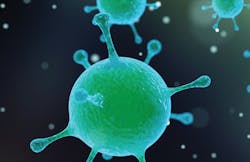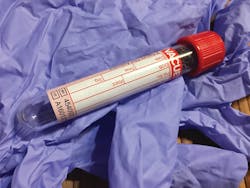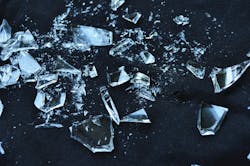In an ideal world, not only does your lab have an active infection prevention and control (IPC) program in place, but a dedicated IPC supervisor who regularly trains staff in emergency preparedness procedures or “spill drills.” Your laboratory also conducts audits every month to identify real and perceived safety hazards and passes with flying colors every time.
But this isn’t always the reality.
Although we all have room for improvement, the importance of cleaning tasks, while not the most enjoyable aspect of a laboratorian’s job, is a mandatory aspect of lab safety and IPC. Keeping the laboratory clean and safe is imperative not only to your safety but the lab’s ultimate success.
Below are some basic tips for cleaning the lab and keeping it safe:
Clean every day
Every lab should have a housekeeping checklist. The checklist should include basic routines like cleaning and clearing countertops and workbenches. The floors should be swept as well as doing a wet mop of the biohazardous areas at least once per day. Touchpoints like doorknobs, light switches, and telephones should also be sanitized.1
Be aware of your surroundings
It’s good practice to ensure aisles are clear, especially if a pathway leads to an evacuation route. A haphazard wire from a computer, for example, could cause a staff member to trip and fall. Tie wires up if necessary. Be sure the floors are clean and replace anti-fatigue mats on a regular basis. If there’s wax buildup in histology areas, use scrapers to remove the wax.2
Address messy workspaces
Cluttered workbenches can be hazardous and contain hidden dangers. Paper strewn about can easily hide sharps, infectious materials, and unknown chemical hazards. In addition, fans should not be used in the laboratory in order to cut down on dust. Dusting should be routine.2
Handwashing stations
All employees should wash their hands on a regular basis. Up to 90 percent of healthcare workers do not wash their hands. Make sure the sinks for handwashing are clean, disinfectant soap dispensers are full, and paper towels are easy to reach. Sink clogs can cause backup that may lead to contamination; be sure sinks are functioning properly.1
Gloves
The percentage of wearing gloves as part of a daily routine for laboratorians should be at 100 percent. There’s no excuse as to why a staff member in the lab would intentionally forgo wearing gloves. Placing reminders throughout the lab helps staff remember to always wear gloves.
Personal protective equipment
Personal protective equipment (PPE) is gear or clothing used to protect the wearer from specific hazards and hazardous materials. It is the final protection system to be used when administrative and engineering controls do not reduce risk to an acceptable level. PPE does not reduce or eliminate the hazard—it only protects the wearer.
Maintaining PPE is a very important part of laboratory safety. Literature or meetings about what kind of PPE, when it is necessary, how to wear it, and how to care for it can be helpful for staff to refresh their memory on proper procedures. Do you know how to properly remove gloves without contaminating yourself? It may seem like a simple question, but believe or not, not everyone in your lab knows how.
Lab coats, gloves, and safety eyewear are the basic PPE needed in a lab. Additional PPE may be needed for other hazards. Your ICP supervisor should be regularly assessing your lab’s general and specific PPE needs and ensure PPE is provided and properly used in the laboratory.
Keep lab equipment clean
Lab equipment should be checked for cleanliness, often. When an employee is done using lab equipment, it should be cleaned according to established standards. All employees should keep the lab’s equipment in top condition1 to show their commitment to laboratory stewardship.
A major part of keeping laboratory equipment clean is disinfection protocols. Benches should be disinfected after every work shift and after any spills occur. The CDC recommends a 10 percent bleach solution for disinfection. Labs should choose commercially available brands that are effective at eliminating bacteria, fungi, and viruses. Don’t select a brand that is only effective against more resistant organisms. The product should be left on the surface for the amount of time designated by the manufacturer.2
Glass, of course, is also part of lab equipment and should be cared for either by automatic washing that has a disinfector or manually cleaning beakers, flasks, droppers, and funnels.
Inventory fridge and freezer contents
Not sure if that’s a sandwich or a lab specimen? You would think it would go without saying, but mixing food and specimens is unacceptable. Yet, it still happens. In addition to those friendly reminders for your fellow laboratorians, be sure to inventory the lab’s fridge and freezer contents. Include important information such as origin and expiration dates. Rotate contents to ensure easier inventory maintenance and timely disposal of expired items.1
Inspect emergency equipment
In order to be safe, the lab’s emergency equipment must be inspected. First, schedule regular inspections for the lab’s fire suppression and sprinkler systems. Next, keep first aid kits in easily accessed areas. Last, regularly check fire extinguishers to make sure all units are fully charged and properly stored.1
Maintain emergency stations
Hand in hand with emergency equipment are the stations at which the equipment resides. Ensure emergency eyewashes, showers, and fire extinguishers are unobstructed. Ensure easy access to bloodborne pathogen and chemical spill response kits. Activate components in all stations several times a week to ensure proper operation. Arrange for regular station inspections by qualified technicians.1
Disposal of broken glass
Proper waste disposal
It is important to work closely with the safety coordinator to determine the best methods for removing dangerous waste from the lab. Instruct all lab staff in strict adherence to policies applying to poisons, heavy metals, carcinogens, and other hazardous wastes.1
Outsource large cleaning jobs
Sometimes the task at hand is just too large or too messy to handle and you must call in the professionals. If you haven’t already, establish a reliable backup of industry certified cleaning crews. A commercial cleaning contractor can tackle a variety of projects including full facility air duct cleaning, deep carpet cleaning and stain removal, post-remodel and construction cleanup, and mold removal and remediation.1
Conduct audits
Lab directors should conduct audits of their department’s physical environment to identify safety hazards specific to their lab. Audits do not need to interfere with day-to-day activities, and they should be performed on a regular basis—at least monthly.
Changes can occur in a lab at any time and the implications of change should be recognized, including the movement of instruments, the placement of new equipment, and the movement and/or stocking of new supplies.1
UVC disinfection
Ultraviolet (UV) disinfection is a technology that can be a supplemental cleaning measure for laboratories that is environmentally friendly—which is especially nice for those committed to sustainability. UV light is a form of light invisible to the human eye that exists on the electromagnetic spectrum between X-rays and visible light. We are exposed to low levels of UV light from the sun’s rays every day, although much of the UV energy is absorbed by the ozone layer.4
The high energy from short wavelength UVC light is absorbed in the cellular RNA and DNA, damaging nucleic acids and preventing microorganisms from infecting and reproducing. This absorption of UVC energy forms new bonds between nucleotides, creating double bonds or “dimers.” Dimerization of molecules, particularly thymine, is the most common type of damage incurred by UVC light in microorganisms. Formation of thymine dimers in the DNA of bacteria and viruses prevents replication and inability to infect.4
Create a strong lab safety culture
After all is said and done, creating and maintaining a clean, safe, and successful lab boils down to one thing: A strong lab safety culture.
A few key tips to keep in mind:
- Everyone involved in laboratory operations—from the highest administrative position to each and every laboratorian—must be safety minded.
- Safety awareness can become part of everyone’s habits only if senior and responsible staff demonstrates a sincere and continuing interest in safety and discusses it repeatedly.
- Over-familiarity with a particular laboratory operation may result in overlooking or underrating its hazards. This attitude can lead to a false sense of security, which frequently results in carelessness.
- Be alert to unsafe conditions and actions and call attention to them so that one can make corrections as soon as possible.
- Every laboratory worker has a basic responsibility to himself/herself and their colleagues to plan and execute laboratory operations in a safe manner.
REFERENCES
- Rodriguez-Zaba, D. (2019). A Lab Cleanup Checklist: 11 Steps to a Safer Work Environment. ServiceMaster. [online] ServiceMaster Restoration by Zaba. Available at: https://www.servicemasterbyzaba.com/blog/laboratory-maintenance-checklist/. [Accessed 1 Feb. 2019].
- Scungio, D. (2018). Keeping the laboratory environment clean and safe. [online] MLO-online.com. Available at: https://www.mlo-online.com/keeping-the-laboratory-environment-clean-and-safe. [Accessed 5 Feb. 2019].
- Eden P. and Hanson, J. (2018). Medical laboratory safety management. [online] MLO-online.com. Available at: https://www.mlo-online.com/medical-laboratory-safety-management. [Accessed 5 Feb. 2019].
- Tru-D SmartUVC. (2019). Tru-D SmartUVC Ultraviolet Disinfection UV Light Disinfection - Tru-D. [online] Available at: https://tru-d.com/. [Accessed 5 Feb. 2019].




